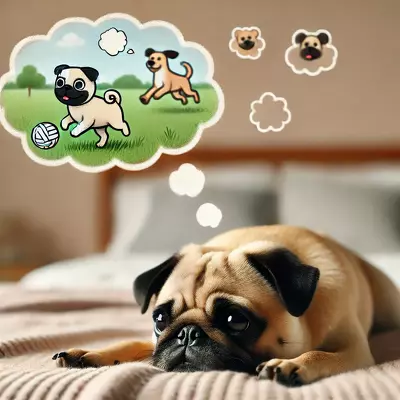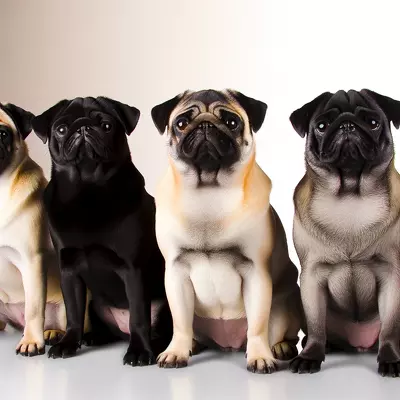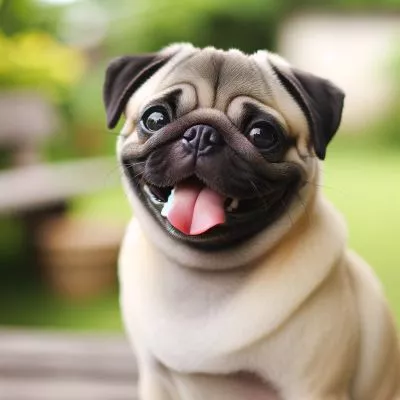From Playtime to Dreamtime: Understanding What Pugs Dream About

Ever wonder what flits through the mind of your pug nestled in their cozy bed? These charming canines, known for their expressive faces and gentle dispositions, experience a rich tapestry of dreams. Just like humans, dogs enter a REM sleep phase, where most dreaming occurs. Observing their twitching paws and soft whimpers might give us clues to their dream content, from chasing squirrels to enjoying a feast fit for a pup prince.
I. Introduction to Canine Dreaming
A. The Sleep Cycle of Pugs
Pugs, much like their human companions, go through various sleep stages, including the rapid eye movement (REM) phase, where dreaming predominantly occurs. This particular stage can offer fascinating insights into the minds of our furry friends.
B. Understanding Dog Dreams
Dreams in dogs are not just a sleep phenomenon but a reflection of their day-to-day life and instincts. When pugs dream, their subconscious might be processing the day’s events or practicing innate behaviors.
C. Comparing Human and Pug Dreaming
There is an intriguing parallel between what pugs dream about and the dreams of humans. Both species display similar neurological patterns during sleep, suggesting that our Pug’s dreams might be more familiar than we realize.
II. The World of Pug Dreams
A. Physical Signs of Dreaming in Pugs
Twitching ears, paddling feet, and quiet barks are tell-tale signs that a pug is dreaming. These physical manifestations are Pug’s reactions to the dreams they are experiencing.
B. Common Themes in Pug Dreams
Pugs may dream about everyday activities like playing fetch or their favorite treats. Their dreams are influenced by the activities they engage in when awake, which could range from playful encounters to moments of affection with their owners.
C. The Science Behind Dreaming Dogs
Research indicates that dogs have complex dreams and can even have nightmares. Studying the REM cycle of pugs provides insights into how they dream and what those dreams may consist of.
III. Factors Influencing What Pugs Dream About
A. Daily Activities and Experiences
The day’s activities are likely to influence a pug’s dreams, where vivid memories of playing, eating, and exploring are replayed in their sleep.
B. Emotional State and Well-being
The emotional health of a pug can significantly impact their dreams. Stressful events may lead to less peaceful dreams, while happiness can result in more pleasant dreamscapes.
C. Breed-Specific Traits and Behaviors
The distinctive personality traits of pugs, such as their social nature and love for comfort, may shape the content of their dreams, with dreams possibly revolving around social interactions and comfort-seeking behaviors.
IV. Interpreting Pug Dreams
A. Observing Sleep Behaviors
Closely watching a pug’s sleep behavior can give clues about their dream content. From quiet whimpers to animated limb movements, these actions can serve as a window into their dreaming mind.
B. Connecting Dreams to Reality
It’s believed that pugs might dream about their real-life experiences. An owner’s understanding of their Pug’s day can sometimes be linked to the dream behaviors observed.
C. The Role of Owner-Pug Interaction
The bond between a pug and their owner might also play a significant role in what a pug dreams about, with strong connections potentially leading to dreams filled with their human companions.
V. FAQs
Q: What do pugs typically dream about?
A: Pugs may dream about daily activities such as playing, interactions with their owner, or chasing things, reflecting their instincts and experiences.
Q: Can pugs have nightmares?
A: Yes, pugs can have nightmares, which may be indicated by signs of stress or fear during sleep, like whining or twitching.
Q: How can I tell if my Pug is dreaming?
A: If your Pug is dreaming, you might notice them making twitching movements, softly barking, or moving their paws as if running.
Q: Do the day’s events affect what a Pug dreams about?
A: The day’s events can influence a pug’s dreams, with their experiences potentially replaying in their sleep.
Q: Why do pugs move and make noises in their sleep?
A: These movements and noises are physical reactions to the dreams they’re having, similar to the way humans react during dreams.
Q: What do Pugs symbolize in dreams?
A: While pugs do not symbolize anything in their dreams, in human culture, they often symbolize love, loyalty, and companionship.
Q: What are pugs’ favorite things to dream about?
A: While we can’t know for sure, it’s likely that pugs dream about their favorite activities, such as eating, playing, or spending time with their owners.
Q: Why does my Pug sleep on me?
A: Pugs often sleep on their owners for comfort and security, and it’s a sign of their trust and affection towards you.
VI. Conclusion: The Significance of Dreams in Pugs’ Lives
A. Benefits of Understanding Pug Dreams
Understanding the dreams of pugs can help owners identify their pets’ needs and fears, enhancing their well-being and strengthening the human-animal bond.
B. The Bond Between Pug and Owner
Recognizing the content of a pug’s dreams can provide insights into their inner lives, creating a deeper emotional connection between the pet and the owner.
C. Further Research on Canine Dreams
Continued research into what pugs and other dogs dream about can offer valuable knowledge into canine cognition and consciousness, which may improve our approach to training and caring for our pets.
VII. Suggested Readings
In exploring the fascinating world of canine dreams, certain readings can provide deeper insights. Here is a selection of books that delve into the behavior, psychology, and inner lives of dogs:
- “The Intelligence of Dogs” by Stanley Coren – A comprehensive look at canine intelligence and thought processes.
- “Inside of a Dog: What Dogs See, Smell, and Know” by Alexandra Horowitz – This book provides a thorough examination of the sensory experiences of dogs, including what they might perceive in their dreams.
- “Dogs That Know When Their Owners Are Coming Home” by Rupert Sheldrake – Explores the deep bond between dogs and their owners, potentially relevant to understanding shared experiences in dreams.
- “The Other End of the Leash: Why We Do What We Do Around Dogs” by Patricia B. McConnell – Offers insight into dog behavior and thought patterns, which could extend to their dream lives.
- “How Dogs Love Us: A Neuroscientist and His Adopted Dog Decode the Canine Brain” by Gregory Berns – Details the first brain-imaging study on dogs and discusses how they might experience emotions during dreams.
These readings not only enhance our knowledge about what pugs might dream about but also deepen our overall understanding of canine companions. Through these texts, we can appreciate the complexity of our pets’ inner lives, paving the way for further discoveries and a more empathetic approach to our four-legged friends.






